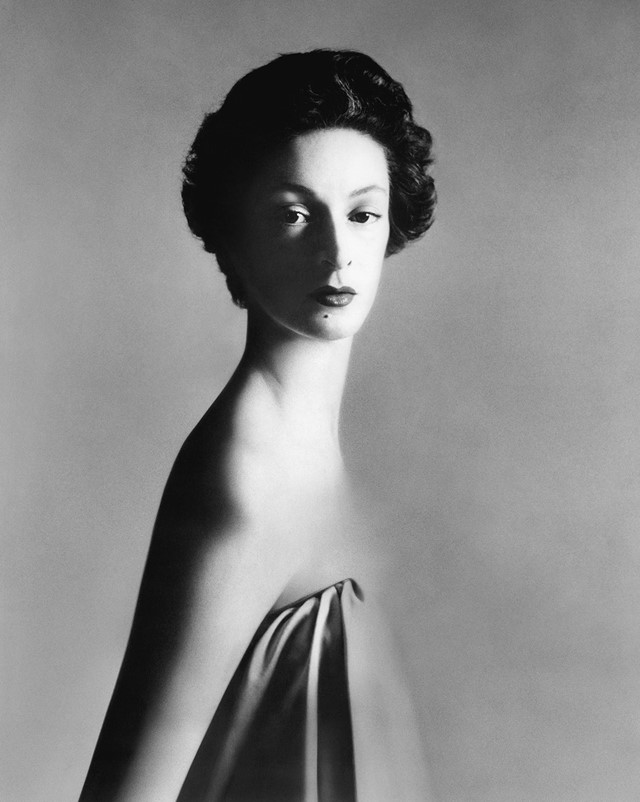Osman Ahmed explores the legacy of Avedon’s 1953 photograph of Neapolitan princess Marella Agnelli, now hanging in The Met
“If Babe Paley and Marella Agnelli were both in Tiffany’s window, Marella would be more expensive,” Truman Capote once told Kate Graham, in whose honour he threw his legendary Black and White Ball. Donna Marella (née Princess Marella Caracciolo di Castagneto) was his European swan numero uno, the youngest of his lamentation of high society swans. She was a Neapolitan princess who married Italy’s richest man. Before that, she worked for Erwin Blumenfeld and Vogue in New York.
Her husband wasn’t so faithful – she likened herself to Penelope, Odysseus’ wife. In 1953, she married him nonetheless in her first Balenciaga dress. It might have had something to do with the fact that she was three months pregnant. It was then that 10 George V became her temple and she became a client of Cristóbal Balenciaga. “If one isn’t very, very beautiful, one should be elegant,” she once told Joan Juliet Buck. “I had to be elegant. Mr Balenciaga was my defence – one presented an image invented by someone else, which was marvellous.” She inspired Viscontian masterworks by some of the century’s greatest tastemakers and became a passionate textile designer. “She has the best taste in the world – of anyone,” Oscar de la Renta told Vogue. “She’s the richest person I know who always wanted to look poor.”
In 1953, Richard Avedon made a portrait of Donna Marella that would become a part of history. It was Diana Vreeland (then the fashion editor of Bazaar) who sent Avedon to photograph Agnelli. Vreeland saw the nobility in her face long before he did. He, however, saw her more as an emu or a giraffe, so he declared: “Off with her hair!” It was then that the Modigliani neck and Brâncuși skin clicked.
By 1953, Avedon had begun making portraits of actresses and socialites with an abstracted, high-contrast effect, bleaching out details on the skin of the face, neck and shoulders, which are often bare. By then, he had developed what he called the “Beauty Light”, a big 1,500-watt Saltzman floodlight with two scrims of spun fibreglass across the front that did wonders for a subject’s bone structure. An assistant would be holding it on its aluminium stand and following the subject’s every movement.
“He used brilliant focused light in a way that seems to hold the contours of his subjects into an almost sculptural form,” wrote Carol Squires in Avedon Fashion 1944-2000. “These portraits were made to convey an array of positive qualities in the women he photographed, from contemporary ideas of beauty to the poetics of artistic talent.”
They also reproduced extremely well in magazines. The portrait of Agnelli appeared in a feature alongside portraits of Audrey Hepburn, Leslie Caron and Gloria Vanderbilt in a feature called “Beauty of Our Time” in the April 1954 issue of Harper’s Bazaar. Each of them was lauded for their unusual, modern beauty. In the case of Agnelli, the text referred to her “dark Italian beauty of a tightly drawn out, linear classicism”. Avedon himself was charmed. “None of the women I consider beautiful have perfect features,” he later said. “If there’s one thing that moves me, it’s when something unexpected happens in the face or the proportion. The most beautiful woman I ever photographed was Signora Gianni Agnelli.”
In the portrait, Agnelli epitomises a beauty that transcends fashion – there are no accessories and no distinctive garment to distract from the handsome line of her neck leading down to her bare back and arm, aquiline nose and majestic, penetrating gaze. Her dark-eyed beauty is strong featured with a self-assured confidence, not to mention utterly far away from the perky American ideal of mid-century beauty. To paraphrase photographer Hiro’s observation about Avedon and fashion, Avedon did not just photograph beauty, he helped define and create the prevailing forms of modern beauty.
It caught on, too. The next season, Christian Dior, whom Avedon considered the “greatest artist of dressmaking”, sought out Harper’s Bazaar editor-in-chief Carmel Snow at the collections to tell her that he loved the photo so much that it had been the inspiration for his new narrow, subtly fitted, elongated ‘ligne H’ – ‘H-silhouette’ – with long torsos and wide necklines.
Avedon would go on to photograph Agnelli more than once, but this portrait became his signature for fashion photography and portraiture. He even made it the opening to his retrospective at The Met, a major exhibition of his work that broke several records. Yet, Richard Avedon could be disparaging of Agnelli at times, insisting he had practically invented her when she was just a down-at-her-Ferragamos principessa playing at working in the big apple. Avedon liked to remind people that the society stardom of Agnelli was the result of him. “It was the effect of I don’t know how many bottles of bleaching agent,” he once mooted.
Still, it was taken the year after Agnelli became one half of Italy’s most glittering power couple and she would go on to become a great beauty of her day and the chatelaine of some of the most beautiful houses in the world. Today, the Avedon portrait of her hangs within The Met.
